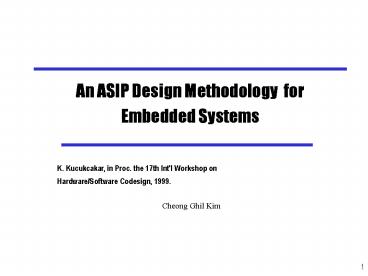An ASIP Design Methodology for Embedded Systems - PowerPoint PPT Presentation
1 / 15
Title:
An ASIP Design Methodology for Embedded Systems
Description:
Fetched and decoded by processor ... Dynamic decode architecture. New instructions: defined per application basis. Decoding is performed by the programmable logic ... – PowerPoint PPT presentation
Number of Views:330
Avg rating:3.0/5.0
Title: An ASIP Design Methodology for Embedded Systems
1
An ASIP Design Methodology for Embedded Systems
K. Kucukcakar, in Proc. the 17th Int'l Workshop
on Hardware/Software Codesign, 1999.
- Cheong Ghil Kim
2
Contents
- Introduction
- Related Work
- Approach
- Results
- Conclusion Future Directions
3
Introduction (1/2)
- Application Specific Instruction-Set Processor
(ASIP) - An alternate processor design method for
dramatically changing computing environment. - More flexibility than ASICs
- Smaller silicon area than GPPs.
- Some overhead for all other applications
- ASIP design task
- Creation of a new processor
- Whose instruction set and architecture are
customized for a targeted set of applications.
4
Introduction (2/2)
- Goals for this paper
- A unique architecture and methodology to design
ASIPs in the embedded controller domain. - System efficiency stays acceptable for embedded
systems. - Cost, code size, performance, and power
- Customization should be as local as possible.
- Changes to the software environment should be as
minimal as possible. - Backward compatibility for the bulk of the
software should be preserved. - Variable degrees of manufacturing flexibility is
possible - Custom
- Mask programmable
- Field programmable
5
Related Work (1/3)
- Scope
- Custom processor design
- MC68HC12 and DSP
- Combination of
- Instruction-set definition
- Architecture creation
- Instruction mapping onto a newly created
architecture - Instruction-set architecture design
- Pass the software through a profiler which
provides an importance factor for each
operation. - Architecture consists of
- A kernel primitive RTL operators, register file,
multiplexers, control, and buses - Application specific ALU
- Simple and restrictive
6
Related Work (2/3)
- Instruction-set definition instruction
selection - An analysis tool is used to extract operations
and operations sequences from an application. - Instruction-set description in mML
- Datapath parts creation by manual
- Operations are bundled to create instruction
formats. - Instruction-set architecture design
instruction mapping from an application and
architecture template - Architecture template defines the pipeline
structure which consists of fetch, decode,
register read, ALU operation, memory access and
register write phases
7
Related Work (3/3)
- Approaches given above
- Tuning for a set of application
- A new instruction set
- A new architecture
- Problems
- Create extreme fluidity in the processor
- Require very effective hardware synthesis and
retargetable software compilers - Ignore control aspect of design
8
Approach (1/5)
- Customizing an existing processor (proposed
method)
9
Approach (2/5)
- Design flow
- A software implementation using traditional
methods - Performance bottlenecks are identified with the
aid of a profiler program - The processor is customized through addition of
applicaion-specific instructions. - The firmware is updated to use new instructions
10
Approach (3/5)
- Identification of new instructions
- Frequently used subroutines in the firmware
- Device drivers
- Basic elements of computation
- Timer operations
- Operating system primitives such as schedulers
- Sequences of common instructions in the
application - Shift-and-add sequence
- Zero-overhead loops
- Data type conversion
- Data formatting for I/O
- Signal polling
11
Approach (4/5)
- Processor architecture
- A fixed set of instructions datapath new
control and datapath logic through use of
programmable hardware - Characteristics
- Applicable to most industrial processors
- Programmable logic reduce the time-to-market
- Lack of efficient access to processor internals
- Static decode architecture
- New instructions a set of predetermined opcodes
- Fetched and decoded by processor
- Processor relinquish the control of datapath to
the programmable section - Dynamic decode architecture
- New instructions defined per application basis
- Decoding is performed by the programmable logic
- Processor sends a signal to the programmable
logic section
12
Approach (5/5)
- ASIP implementation
- RTL synthesis
- Behavioral synthesis
- Reuse of code segments from existing instructions
in definition of the new instructions - Easy partitioning of new instruction logic from
the existing implementation - Firmware modification
- Assembly code
- Addition to compiler
- Retargetable compilers
13
Results (1/2)
- Hex-to-binary conversion example
- Control oriented operation
- 75 reduction in the number of cycles by
eliminating - Unnecessary instruction fetching
- Data passing between instructions
- Creating unused information
- Program memory reduction 39 bytes to 1 byte
14
Results (2/2)
- 16 16 multiply example
- Not a control oriented operation (mostly
shift-and add multiplication) - 3 different instruction implementation
- A exploits a programmable control section with
no datapath extension - B add an 88 single-cycle hardware multiplier
- C addition of eight-location register file
- Program memory reduction 51 bytes to 1 byte
15
Conclusion Future Directions
- ASIP architecture co-design methodology to
improve the performance of embedded system
application through instruction-set
customization. - Demonstrate the significant benefits on control
and data oriented applications. - More automation in the methodology would enable
automatic HW/SW partitioning capability.































